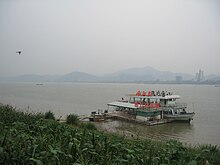Xijiang
| Xi Jiang | |
|---|---|
 |
|

The Pearl River system including the Xi River
|
|
| Country | China and Vietnam |
| Basin | |
| Main source | Gui Jiang and Xun Jiang in Wuzhou |
| River mouth | The Pearl River Delta on the South China Sea |
| Physical characteristics | |
| Discharge |
|
| Features | |
| Tributaries |
|
| Xi River | |||||||||||
| Chinese | 西江 | ||||||||||
|---|---|---|---|---|---|---|---|---|---|---|---|
| Cantonese Jyutping | Sai1 gong1 | ||||||||||
| Hanyu Pinyin | Xī Jiāng | ||||||||||
| Postal | West River | ||||||||||
| Literal meaning | West River | ||||||||||
|
|||||||||||
| Transcriptions | |
|---|---|
| Standard Mandarin | |
| Hanyu Pinyin | Xī Jiāng |
| Yue: Cantonese | |
| Jyutping | Sai1 gong1 |
The Xi River (Chinese: 西江) is the western tributary of the Pearl River in China. It is formed by the confluence of the Gui and Xun Rivers in Wuzhou, Guangxi. It then flows east through Guangdong, and enters the Pearl River Delta just east of the Lingyang Gorge in Zhaoqing. The main branch of the Xi River flows southeast through the delta entering the South China Sea at Modao Men, just west of Macau. The major cities along the Xi include Wuzhou, Zhaoqing, and Jiangmen.
The other two main tributaries of Pearl River are the Dong River (literally, the East River) and Bei River (the Northern River).
The Xi River is navigable for its entire length. It is a commercial waterway of southern China, and links the delta cities to the interior. Over two thousand years ago, the Lingqu Canal was dug, connecting the Xi River basin (the Li River, which is a tributary of the Gui River) with the Xiang River, which flows into the Yangtze, thus providing a continuous waterway from the Pearl River Delta to the Yangtze Valley.
The entire Xi River system is the largest of the Pearl's tributaries at 2,197 kilometres (1,365 mi) in length, and its volume of flow is second in China only to that of the Yangtze River. It supplies water to many places in Guangxi, Guangdong and Macau.
...
Wikipedia
